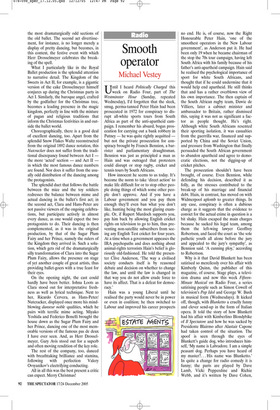Magical touch
Giannandrea Poesio
The Nutcracker Royal Ballet Oh joy, oh bliss, it is Nutcracker season again! Hordes of overdressed and overexcited children invade our theatres, much to the despair of those who know that the kids’ excitement and attention will fade as soon as they realise that neither the Mouse King nor the Sugar Plum Fairy can be incinerated by one of Lord Voldemort’s spells. Indeed, a Harry Potter-esque version of the unsinkable classic could be an appropriate addition to the long series of radical, humorous, gothic and psychoana lytical versions of the 1892 ballet that we have seen in the past years. Yet, London balletomanes will find no such thing, nor any other new Nutcracker in their stockings this year.
Luckily, one may add, for it is about time that good standard versions of the classic were given a chance to dominate the Christmas ballet scene again. Take, for instance, the luscious Royal Ballet production, which, thanks to the genius of Peter Wright and the contributions of dance scholar Roland John Wiley, relies on unique theatre magic as well as on a thorough exploration of the ballet’s historical sources. As such, this is Nutcracker at its best and Nutcracker as it should be.
In line with the Romantic writings of E.T.A. Hoffmann on which the ballet libretto was based, in this production the action develops through the effective combination of two narratives: the story of young Clara’s magic journey to the Kingdom of Sweets and the story of the magician Drosselmeyer’s nephew, HansPeter, who has been turned into the Nutcracker Doll by an evil spell. It is Drosselmeyer who, wanting to rescue his nephew, conjures up the magic events in which Clara, his goddaughter, participates. The godfather’s magic thus becomes the key element of the entire story. His presence, moreover, provides the fairytale with a logical fluidity and even justifies some of the most dramaturgically odd sections of the old ballet. The second act divertissement, for instance, is no longer merely a display of pretty dancing, but becomes, in this context, the festive event with which Herr Drosselmeyer celebrates the breaking of the spell.
What I particularly like in the Royal Ballet production is the splendid attention to narrative detail. The Kingdom of the Sweets in Act II, for example, is a gigantic version of the cake Drosselmeyer himself conjures up during the Christmas party in Act I. Similarly, the baroque angel, crafted by the godfather for the Christmas tree, becomes a leading presence in the magic kingdom, perfectly in line with the mixture of pagan and religious traditions that inform the Christmas festivities in and outside the ballet world.
Choreographically, there is a good deal of excellent dancing, too. Apart from the splendid Snow Flakes Waltz reconstructed from the original 1892 dance notation, this Nutcracker does not suffer from the traditional discrepancy found between Act I the more ‘acted’ section — and Act II in which the most famous dance numbers are found. Nor does it suffer from the usually odd distribution of the dancing among the protagonists.
The splendid duet that follows the battle between the mice and the toy soldiers redresses the balance between mime and actual dancing in the ballet’s first act; in the second act, Clara and Hans-Peter are not passive viewers of the ongoing celebrations, but participate actively in almost every dance, as one would expect the two protagonists to do. Their dancing is then complemented, as it was in the original production, by that of the Sugar Plum Fairy and her Prince, namely the rulers of the Kingdom they arrived in. Such a solution, which gets rid of the dramaturgically silly transformation of Clara into the Sugar Plum Fairy, allows the presence on stage of yet another couple of great artists, thus providing ballet-goers with a true feast for their eyes.
On the opening night, the cast could hardly have been better. Iohna Loots as Clara stood out for interpretative freshness as well as lyrical technique. Next to her, Ricardo Cervera, as Hans-Peter/ Nutcracker, displayed once more his mindblowing danseur noble qualities, which he pairs with terrific mime acting. Miyako Yoshida and Federico Bonelli brought the house down as the Sugar Plum Fairy and her Prince, dancing one of the most memorable versions of the famous pas de deux I have ever seen. And, as Herr Drosselmeyer, Gary Avis stood out for a superb and often moving rendition of the key role.
The rest of the company, too, danced with breathtaking brilliance and stamina, following with perfection Valery Ovsyanikov’s electrifying conducting.
All in all this was the best present a critic can expect. Merry Christmas!



















































































 Previous page
Previous page